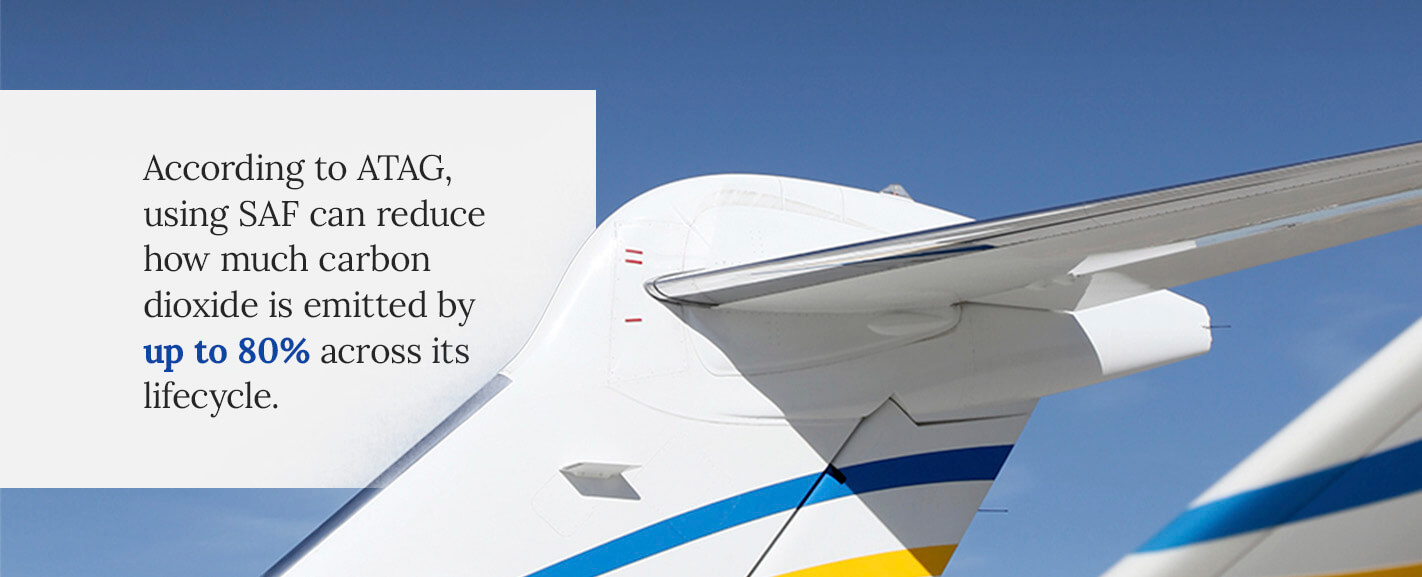
The aviation industry has committed to achieving net-zero carbon emissions by 2050. Developing cost-efficient green aviation fuel will be critical for reaching this goal, which is why investing in the development of sustainable aviation fuels is so important.
According to the Air Transport Action Group (ATAG), sustainable fuels could cover approximately 2% of aviation fuel demand by 2025 with sufficient investment. Understanding what SAF is and the benefits it can bring is essential for maintaining a competitive edge and improving airline sustainability moving forward.
What Is Sustainable Aviation Fuel (SAF)?
Sustainable Aviation Fuel (SAF), also known as aviation biofuel, is a sustainable alternative to traditional jet fuels. It is a blended product that combines fossil fuel with sustainable fuels made from plant-based or waste products.
SAF has a chemical composition that is almost identical to conventional jet fuels, so it meets the industry’s strict standards for quality. For example, you can use SAF in aircraft that require Jet A or Jet A-1 fuel without needing to make extensive modifications to your engine system.
Airlines have been using SAF since 2008 when the first technical test flight took off in New Zealand. It became commercially available in 2011 and has slowly gained popularity ever since.
Optimizing production is vital for making aviation biofuels more available to airlines. The U.S. federal government has set a goal to scale up SAF production to 35 billion gallons annually by 2050 in an ambitious inter-agency project called the Sustainable Aviation Fuels Grand Challenge. The goal is to meet 100% of aviation fuel demand with SAF by 2050.
What Is Sustainable Aviation Fuel Made Of?
SAF is a blended product that contains a combination of renewable biomass-derived fuel and fossil fuel. According to the Environmental Protection Agency (EPA), U.S.-based harvesters can sustainably collect as much as one billion tons of feedstock annually — enough to produce 50 to 60 billion gallons of biofuel.
Because 100% SAF is still not suitable for safe commercial use, ASTM 7566 defines acceptable requirements for SAF blends. The typical SAF blend ratio is 30% renewable to 70% fossil fuel, but some blends can contain as much as 50% of each.
Three types of sustainable aviation fuels are in development today:
- FOGs: Most of today’s biofuels come from fats, oils and greases (FOGs), such as tallow, vegetable oils or waste greases. Typically, FOG-based SAFs are produced through the hydrotreated esters and fatty acids (HEFA) process, which is the most mature SAF refining process in use today. However, this type of SAF production is difficult to scale to industrial levels.
- Biomass and MSW: Second-generation SAFs are made by refining carbon-based biomass and municipal solid waste (MSW) such as algae, animal waste and agricultural and forestry residues. While it can reduce emissions by 85% to 95% over its lifecycle, this type of SAF is significantly less energy-dense than fossil fuel.
- Power-to-liquid (PtL): This new technology uses electrolysis to convert renewable electricity into fuel. While it has the potential to reduce emissions by up to 99%, it requires enormous quantities of electricity — as PtL use and production increases, it’s likely to become more cost-efficient.
How Is SAF More Sustainable?
While SAF is still fairly new, it has enormous potential for creating radical change in the aviation industry. From generating new economic opportunities to dramatically reducing
When compared to conventional jet fuel, SAF is the more sustainable option for two reasons — the fuel’s clean-burning properties and its environmentally friendly production processes.

Sustainable Aviation Fuel Performance
According to ATAG, using SAF can reduce how much carbon dioxide is emitted by up to 80% across its lifecycle. This reduction is due to the fact that SAF burns cleaner than fossil fuels — because SAFs contain fewer aromatic components than conventional jet fuel, they release fewer emissions.
Scientists and aviation fuel producers have also begun researching negative emissions biofuels, which offset emissions by absorbing more carbon than they release. This development could significantly accelerate the process of achieving industry sustainability goals.
Fuel Production
Because it uses renewable feedstocks, aviation biofuel production is significantly more sustainable than fossil fuel production.
Conventional fuel production removes non-renewable carbon from the earth by drilling, surface mining or fracking. These extraction techniques can generate significant air and water pollution, which can negatively impact nearby communities by contributing to health conditions like asthma and cancer.
Further, transporting and processing fossil fuels releases massive quantities of greenhouse gas (GHG) emissions, which contributes to climate change.
In contrast, SAF production absorbs carbon from the air. It also uses renewable feedstocks, which means it does not deplete natural resources like fossil fuels, which are non-renewable. As a result, producing SAF has no impact on climate change.
The Benefits of Sustainable Aviation Fuel
The benefits of using SAF go beyond simply reducing emissions. Some of the top advantages of this technology include:
- Environmental benefits: According to the Waypoint 2050 analysis, SAF will be a major contributor to reducing emissions — estimates say it will make up between 53% and 71% of the reductions needed to reach net-zero by 2050.
- Engine compatibility: SAF is chemically similar to traditional jet fuels, making it compatible with any jet engine system that uses Jet-A or Jet A-1 fuels. You can easily switch to SAF without needing to make costly modifications to your aircraft.
- Diversified feedstocks: Fossil fuel production relies on one non-renewable source, so when it runs out, there is no way to produce more. SAF uses a diverse range of feedstocks, enabling producers to switch feedstocks whenever necessary.
- Competitive advantage: Using SAF shows your stakeholders your commitment to sustainable business practices, which can improve your overall reputation and provide customers with a more environmentally friendly option. Additionally, since many airlines are moving to SAF, you can remain competitive in the industry.
- Economic stimulation: Because fuel production infrastructure is often installed close to feedback sources, increasing SAF production can generate new economic opportunities worldwide. ATAG estimates that shifting to SAF could create as many as 14 million jobs globally.
- Expanded supply: Only 22 countries produce 90% of the world’s fossil fuel supply. Switching to SAFs could expand the industry to almost every country on Earth.
Partner With Latitude 33 Aviation for Fuel Discounts
At Latitude 33 Aviation, we’re committed to providing our clients with superior and sustainable service. When you choose us as your aircraft management service partner, we can purchase fuel for you at up to a 50 percent discount, helping you reduce your ownership costs so you can invest in more sustainable alternatives.
We also offer other administrative services, including world-class crew training, accounting services and revenue generation opportunities.
Learn more about our service offerings by filling out our online contact form. A representative will be in touch shortly to answer any questions you may have.





